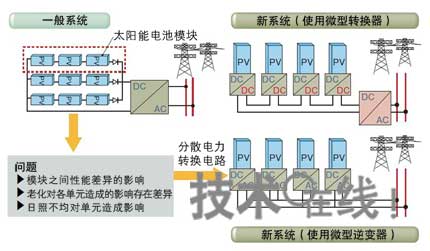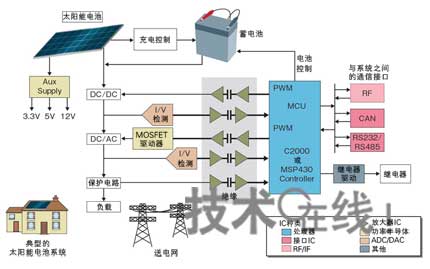Solar cell module revolution
"The solar module is about to usher in a big change. There will be a lot of business opportunities for us." This statement was made by Texas Instruments. The company formed a team specializing in solar cell business in May 2009. The transformation of solar cell modules refers to the way in which multiple solar cell modules are connected in series and then connected to the inverter instead of being equipped with inverters and converters in each module (Figure 1).

Figure 1: Distributed configuration power conversion circuit
After the solar cell system is generally connected in series with the solar cell module, it is connected to an inverter that performs DC-AC conversion (the "general system" in the figure). The new system is provided with a converter for DC-DC conversion in each module, connected to an inverter, or an inverter configured for each module, thereby improving the practical efficiency of the solar cell system. The map is based on data from Texas Instruments.
According to TI, the problem with the previous method is that if there is a module whose output power is reduced due to uneven sunlight and uneven characteristics, the overall output power will be greatly reduced. The solution to this problem is to distribute the inverters and converters. This method, called "micro-inverter" or "micro-converter," has the feature of maximizing the overall output power by optimizing the output power of each module. In addition, when combined with communication capabilities, it can also be used to monitor the status of individual modules and detect failed modules.
Solar cell inverters can be said to be a collection of semiconductor devices (Figure 2). TI intends to use the company's superior technology to increase the product range for micro-inverters and micro-converters, including control ICs that optimize the output power of each module, and communication ICs that are used to communicate the status of each module.

Figure 2: Control Circuit Configuration of the Inverter
The solar cell system uses a common inverter control circuit. Need to use a variety of semiconductors. The map is based on TI's data.

Figure 3: The reason why the accuracy must reach 16bit
The power monitoring circuit in the power transmission system requires a high-precision measurement voltage. To meet the required values ​​and perform digital control, the 16-bit digital conversion of the analog data provided by the sensor is required. The map is drawn from the information of Maxim.
The micro-inverter is equipped with existing inverter functions on each module, and the optimization of output power to DC-AC conversion is performed by the module. Because the power output from the module is AC, it can be directly connected to the grid, so construction is easier. Companies expecting to install equipment for residential or commercial facilities have this need.
On the other hand, the micro-converter performs the output power optimization and DC-DC conversion for each module, and the remaining DC-AC conversion is performed by an additional set of inverters. Since the power output from the solar battery module is direct current, it is suitable for applications such as charging the battery with the generated power directly in a direct current state. For example, there is a need for this in non-powered areas such as wireless communication base stations and other independent facilities that do not have access to the power grid.
Laser Cutting Parts,Metal Fabrication Laser Cutting Parts,Steel Laser Cutting Plates,Metal Laser Cutting
JIANGSU TONGDE INTERNATIONAL TRADE CO.LTD. , https://www.tongdetrades.com